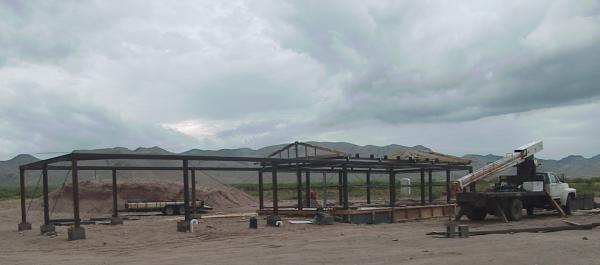My interest in astronomy dates back to the time when I, as a third-grader, got a copy of Fred Hoyle's Frontiers of Astronomy. I read it over and over, practically memorizing it, fascinated by the idea that we could actually figure out what was going on inside a star, an object that was just a tiny pinpoint of white light.
It wasn't too long after that that I got a small telescope; later, as a high-school freshman, I got a larger telescope. It wasn't too long after that that I wanted an observatory so I wouldn't have to lug the thing in and out of the house!
Lo these many years later, the time for an observatory has come. After a protracted search of the numerous places in the southwest desert that qualify as near, at, or in the middle of nowhere (so the sky will be nice and dark at night, that's why), but still within shouting distance of utility service, land has been procured. What follows is the chronicle of the transformation of 40 acres of high desert into my vision of astronomical nirvana.
So, like Dorothy, we begin by putting one foot in front of another as we follow the treacherous road to The Emerald City (or at least an observatory with electricity and indoor plumbing :-).
FLASH! (3/17/00): Ten months on the waiting list has finally paid off - I've been allowed to place an order for an Astro-Physics 1200GTO mount. Delivery time is sometime this fall; unfortunately, the observatory will be nowhere near completion when it arrives.
FLASH! (07/26/00): An order was placed today for a 400mm (16") Astro Optik LOMO Hypergraph, which will be the main imaging instrument at the observatory. Delivery time is 10 - 12 months; at the current rate, the observatory will not be ready when the telescope gets here.
FLASH! (08/24/00): I placed the winning bid on Astromart (a used astronomy equipment forum) for a slightly used Software Bisque Paramount GT-1100B mount. This will be the mount for the second pier in the observatory. Now if I only had a telescope ...
FLASH! (11/29/00): The Astro-Physics 1200GTO mount I ordered 'way back on March 17 has finally arrived! Somehow, it looks out of place sitting on the floor in the library - I sure hope this observatory gets done soon!
At long last, the steel framework for the building is erected, and, as you can see, a few of the roof trusses are in place. The siding arrives on Monday, and we expect that the building will be completed this week. (Well, OK, there's no floor inside the building yet, but we'll get to it ...)
Note the dark, threatening skies (again) - while it provides welcome shade from the brutal summer sun, it also keeps us alert for lightning. Working on a 10-foot-tall steel framework with lightning in the area is something we're all rather reluctant to do.
To the right, you can see the boom truck that we used to erect the steel and the trusses. (If you thought I was hoisting 700-pound 6x6 steel columns by hand, thank you! But I must regrettably report that you are mistaken.)

Compare this to:
The largest steel members are the 40-foot 6x6x.250 steel tubes running horizontally in the foreground - these support the roof as it rolls off the building, and weigh 761 pounds each. It didn't take much mental arithmetic to figure out that we were going to need some mechanical help unloading the truck bringing the steel and more help hoisting it into place. So a boom truck was engaged to do the lifting; this greatly enhanced our fear of lightning with the boom sticking up 60 or 70 feet into the air!
All of this steel is firmly welded together to form a solid structure to withstand the occasional 100 mph winds that can come through this valley; that can put a tremendous amount of pressure on the building siding. And, since there are of necessity no cross-members inside the building, the walls must withstand that pressure on their own. Hence the massive size of the steel members making up the frame.
After a promising beginning, the roof is turning out to be quite difficult to roll. This is bad news, because it means I can't move it by hand and it will be difficult to engineer a strong-enough motorized drive mechanism. We'll have to do some work on this - the roof cannot remain this difficult to move.
The Bunker Ranch Observatory owes its name to my builder. He tells everybody who asks that he's building a bunker, in reference to the buried basement. A while ago, he presented me with a sign dubbing this site the "Bunker Ranch". So it seemed most fitting to name the facility the "Bunker Ranch Observatory".
Next up: rolling the roof
Return to The TRF House of Astronomy
The TRF Housing Tract Home Page
Terry R. Friedrichsen
terry@venus.sunquest.com